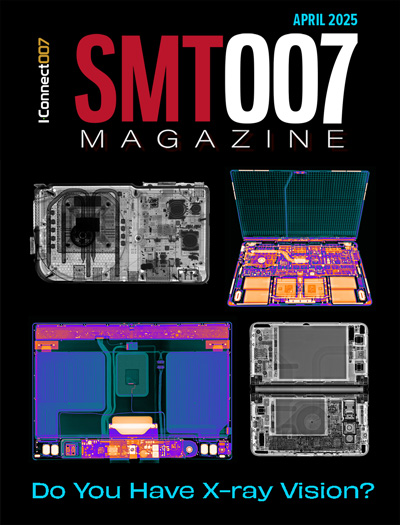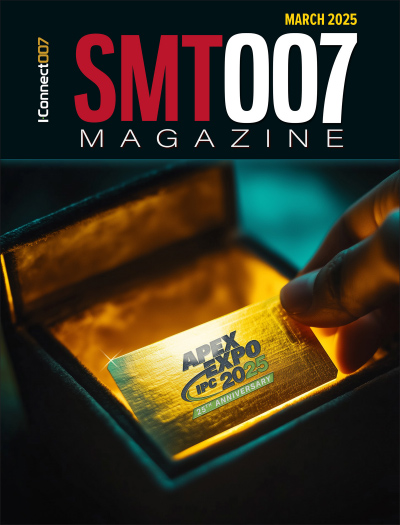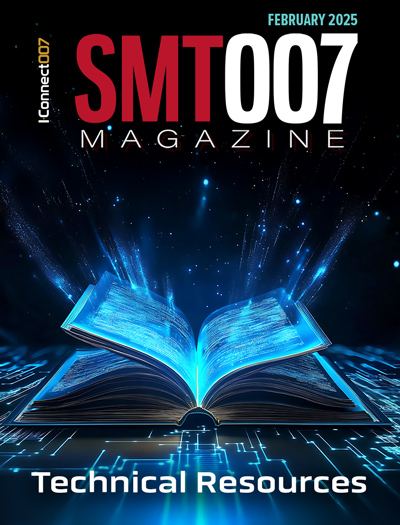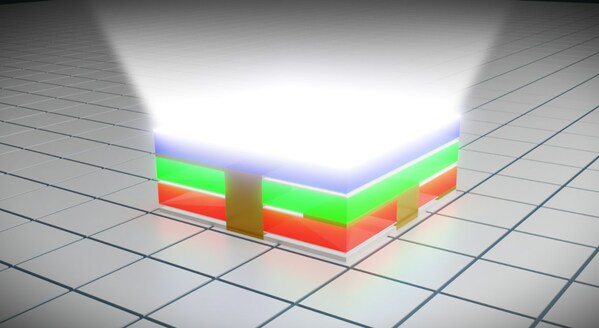-

- News
- Books
Featured Books
- smt007 Magazine
Latest Issues
Current Issue
Do You Have X-ray Vision?
Has X-ray’s time finally come in electronics manufacturing? Join us in this issue of SMT007 Magazine, where we answer this question and others to bring more efficiency to your bottom line.

IPC APEX EXPO 2025: A Preview
It’s that time again. If you’re going to Anaheim for IPC APEX EXPO 2025, we’ll see you there. In the meantime, consider this issue of SMT007 Magazine to be your golden ticket to planning the show.

Technical Resources
Key industry organizations–all with knowledge sharing as a part of their mission–share their technical repositories in this issue of SMT007 Magazine. Where can you find information critical to your work? Odds are, right here.
- Articles
- Columns
Search Console
- Links
- Media kit
||| MENU - smt007 Magazine
Micro-LEDs: The Luminous Future of Immersive Displays by Rayleigh Vision
October 16, 2023 | PR NewswireEstimated reading time: 4 minutes
"Apple's venture into mixed reality, albeit remarkable, is tethered to Micro-OLED displays. These come with their baggage—like soaring costs, compromised brightness, and longevity concerns," shared Dr. Eddy Hsu, the co-founder of the influential Rayleigh Vision with over 20-year experience in Micro-LED technologies.
Micro-LEDs: The Luminous Future of Immersive Displays by Rayleigh Vision
The microdisplay research team, led by Professor Jr-Hau HE at City University of Hong Kong and its spin-off company Rayleigh Vision, has made significant advancements in Micro-LED technologies to overcome the current limitations. Their newly announced two-layer Micro-LED array showing a cutting-edge stacking technology, to craft dual-layer units where each layer can modulate colors independently. The team's stacking processes have gained initial validation and are on track to cultivate an RGB full-color Micro-LED. This advancement is expected to double the pixel density of current planar devices or more. This product boasts high contrast, high brightness, wide color gamut, high efficiency, low power consumption, and long lifetime, making it suitable for a wide range of applications in entertainment, consumer electronics, and professional industries.
With hubs in California, Hong Kong, and Taiwan, it's Rayleigh Vision's approach to Micro-LEDs that has industry insiders talking. The team has launched several products, such as the 0.55" full-color Micro-LED microdisplay and an impressive 0.38" monochromatic Micro-LED microdisplay boasting a pixel density of 3780 ppi. Moreover, by achieving a technological feat in successfully cultivating 2.5 μm Micro-LED pixels and building a pixel array with the pixel density exceeding 10,000 ppi, Rayleigh Vision become one of the select teams in the market capable of harnessing this cutting-edge technology.
Dr. He emphasized, "While stacked Micro-LED technology holds immense potential, it also faces several challenges, including precise alignment, repair difficulties, heat dissipation, as well as innovations in the stacked structure and materials used for connecting LEDs. However, Rayleigh Vision has made significant breakthroughs in these areas. At Rayleigh Vision, our stacked Micro-LED products not only offer higher pixel density but also incorporate our patented innovations to achieve higher energy efficiency and superior display quality in terms of brightness, contrast, and color representation. Moreover, our patents also address crucial challenges in the mass production process, including effectively repairing pixel anomalies and cost deduction. Solving these issues is essential for the successful implementation of Micro-LED technology in commercial applications." Leveraging a series of key technologies and multiple patents, Rayleigh Vision has successfully demonstrated the feasibility of mass-producing stacked Micro-LED technology on large-size wafers. This groundbreaking achievement have garnered interest from global electronics powerhouses and leading industrial players. These companies are actively exploring the potential applications of Micro-LED microdisplays in AR/VR/MR glasses as well as other advanced wearable devices.
According to Dr. Hao-Chung Kuo, the director of Semiconductor Research Center at Hon Hai Research Institute, Apple is anticipated to launch its first product using Micro-LED display technology, the Apple Watch, in 2026. Afterwards, the technology will also be applied to the mixed-reality smart glasses Vision Pro. The reason for this choice is that only Micro-LED technology can deliver an exceptional level of detail and the most realistic experience, surpassing the capabilities of LED, Mini-LED, and Micro-OLED. Once mass production becomes feasible and costs are reduced, Micro-LED is expected to be widely applied to various display fields including AR/VR, television, automotive displays, smartphones, wearables, and professional domains. The market potential is deemed to be limitless.
Micro-LEDs are generating increasing excitement, with projections indicating that the market could skyrocket from $500 million in 2022 to a staggering $20 billion by 2027. The allure of this emergent tech hasn't gone unnoticed, as evidenced by the significant investments made last year. Over 20 companies collectively contributed almost $2 billion to advance Micro-LED tech, including Google's substantial $1 billion acquisition of the startup Raxium in 2022.
The technology and production requirements of Micro-LED are higher than ever, relying heavily on a deep understanding of cross-disciplinary knowledge including wafer fabrication, chip design, mass transfer and CMOS manufacturing. There is an increasing number of giants, established manufacturers, and startup companies investing in and conducting research and development in this field, which is expected to accelerate technological breakthroughs and applications within the industry.
Dr. Zhaojun Liu, the founder of Shenzhen Sitan Technology and the Chairman of the SID Micro-LED & QD Committee, elaborated: "In the past, to achieve full-color Micro-LED displays, there have been two main design strategies for device structure. The first is based on the selective mass transfer of RGB Micro-LED chips, where red (R), green (G), and blue (B) Micro-LEDs are used to form individual pixels for full-color display. The second approach involves using blue Micro-LEDs combined with a color conversion layer. The core of this strategy is to use the blue light emitted by the Micro-LEDs to excite corresponding red (R) and green (G) color conversion layers, thereby achieving full-color spectrum display. Each of these design strategies has its own unique advantages and application scenarios. Now, the recently developed stacking technology opens up new avenues for development beyond 2D planes, it will be challenging while seems to be a feasible direction with potential." As stacking technology is gradually becoming one of the key techniques for achieving color Micro-LED Display field, technologies released by Rayleigh Vision has the potential to revolutionize the market landscape.
Suggested Items
YINCAE to Showcase Cutting-Edge Solutions at SEMICON Southeast Asia 2025
04/16/2025 | YINCAEYINCAE Advanced Materials, a leading provider of innovative solutions for the semiconductor and microelectronics industries, is proud to announce its participation in SEMICON Southeast Asia 2025.
Avnet Technology Links STMicroelectronics’ STM32 Microcontrollers
04/11/2025 | AvnetDesign engineers who struggle with chip down design will now be able to quickly prototype and deploy their projects based on STM32 series of microcontrollers, specifically the STM32F7 and STM32N6 series.
Unimicron Joins '2025 TALENT, in Taiwan' Initiative for Second Consecutive Year
04/10/2025 | UnimicronUnimicron has reaffirmed its dedication to talent sustainability and the cultivation of a diverse, equal, and inclusive workplace by joining the "2025 TALENT, in Taiwan, Taiwan Talent Sustainability Action Alliance" for the second consecutive year.
KYZEN to Feature MICRONOX Line of Chemistries at PCIM Europe
04/09/2025 | KYZEN'KYZEN, the global leader in innovative environmentally responsible cleaning chemistries, will exhibit at the PCIM Expo and Conference, scheduled to take place May 6-8 at NürnbergMesse in Nuremburg, Germany.
Infineon Bolsters Global Lead in Automotive Semiconductors with Number One Position in Microcontrollers Driving this Success
04/07/2025 | InfineonInfineon Technologies AG bolsters its global and regional market leadership positions in automotive semiconductors, including its very strong position in microcontrollers.



